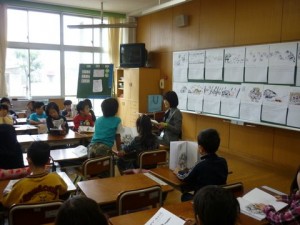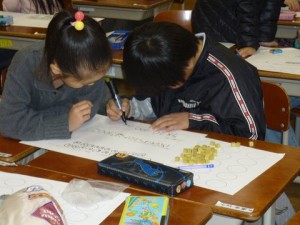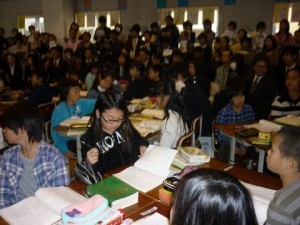Visit to Hamanogo Elemantary School, accompanied by Professors Sato and Akita.
 What an experience! The day started very early with a 6.30am pick-up from the hotel (packed breakfast en-route). Then followed a 2 hour journey by coach to Chigasaki City, south of Tokyo (and with a view of Mount Fuji from the school playground).
What an experience! The day started very early with a 6.30am pick-up from the hotel (packed breakfast en-route). Then followed a 2 hour journey by coach to Chigasaki City, south of Tokyo (and with a view of Mount Fuji from the school playground).
Hamanogo ElementaryScool is a pilot school that has served as a starting point for the spread of learning communities across Japan. Established in 1998, the school is guided by three ideas:
- Public philosophy: the school is charged with fulfilling each child’s right to learn. The school is considered as an open public space, open to the whole community
- Democracy : The purpose of the school is to build a democratic society and schools themselves must, therefore, be democratic social organisations – each schoolchild, teacher and parent participates in the management
- Excellence : Teaching and learning activities are built essentially on the pursuit of excellence ‘the pursuit of the best through utmost efforts brings deep humility and modesty to teachers and learners alike’
The school’s vision is that schools as learning communities are so constructed as to allow public philosophy, democracy and excellence to be acquired and practised spontaneously. Classrooms are organised to support children’s active, cooperative and reflective learning. The system in all classes above third grade require that :
- children organise a collaborative learning system in groups of 4 of both genders;
- they establish a relationship in which they learn from each other;
- they learn to stretch their limits.
Teachers are required ;
- to consistently listen, connect and respond;
- to speak at a lower pitch and choose words carefully;
- to pursue creative teaching by spontaneously responding to children.
In addition to monthly faculty meetings and weekly meetings for each grade, in-school seminars, based on classroom observation are seen as central to the school’s philosophy and development. At least once a year, teachers open their classrooms to their colleagues and present their case studies, where the focus is on the learning as experienced by the children (not on teaching materials or teaching skills).
Every month, hundreds of teachers visit the school. Similar Pilot schools across Japan attract hundreds of teachers – up to 500 may attend an annual open day
On the day we visited Hamanogo school it was their annual open day and included public lessons for 300 Japanese teachers in addition to the conference delegates ( approx. 60). On arrival we were all provided with slippers as, in keeping with Japanese custom, no-one wears outdoor shoes inside the building (imagine providing slippers for almost 400 people!). We were welcomed by the School Principal and were then free to look around the school and visit classrooms.
There then followed the public lessons – a Year 5 reading comprehension lesson and a Year 2 Art lesson. Approximately 200 teachers gathered around to observe the Year 5 lesson taught by Ms. Michiko Fujimori. There were 32 pupils who were seated in 8 mixed groups of 4. An ‘official’ observer was attached to each group.
The unit of work consisted of 11 lessons, of which this was the 7th.There were unit objectives and lesson objectives provided in the plan.
The lesson objective: To be able to understand the feelings and thoughts of characters based on the personality of Omitsu and the views of the carpenter as reflected in the story, ‘God and the Straw Boots’. Each pupil had their own copy of the text book of traditional Japanese tales, which they were able to annotate. On display was also an enlarged version of the text of the story, measuring about 15feet in width by 2.5 width in height in order to accommodate the vertical layout of Japanese script.
The children were asked to read specific sections of the text – they read to themselves but out aloud. When all had finished the teacher asked them to discuss in groups – there was evidence of children helping each other, pointing to different parts of the text for evidence to support their ideas. This was followed by a class discussion, designed to deepen understandings. Children provided extensive feedback ( reminiscent of dialogic talk), with the teacher interjecting rarely but , from time to time, helping the children to take a point further and annotating the enlarged text accordingly. Interestingly, the children appeared to be undisturbed by the 200 or so observers around them.
After lunch the ‘official’ observers, together with the teacher, formed a panel to discuss the lesson and to provide feedback. The teacher was very open about what she thought had been more or less effective in the lesson. The focus throughout was on the learning of individual children.
Overall, an interesting experience but it is difficult to imagine that the format of this Open Day may not translate to schools in Great Britain! However, there were many features which certainly would.


